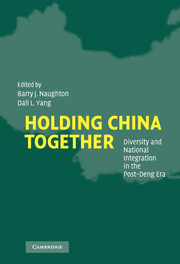Holding China Together: Introduction
Published online by Cambridge University Press: 08 December 2009
Summary
During the 1980s, China experienced a steady decline in central government control over the economy, the political system, and society as a whole. Economic reforms emphasized decentralization of resources and decisionsion-making authority, which empowered local governments and enterprises at erprises at the expense of the national government. Economic liberalization fostered the creation of literally millions of new economic entities, combined with new market rules and incentives. Rapid economic growth not only led to a much larger and more complex economy but also greatly expanded regional diversity. Government demands for conformity receded, allowing a more relaxed and diverse society to develop. Although conservatives sought to roll back some of these reformist changes after the Tiananmen massacre, they were unable to reverse the most fundamental changes. Indeed, there is universal agreement that the 1980s witnessed a historic retreat of the Chinese central government. Given breathing space by the rollback of the Chinese state, Chinese society and the Chinese economy came alive.
Nevertheless, the decline in the authority of the Chinese state was not a smooth or trouble-free process. Like governments in all transitional economies, China's leaders abandoned crude but powerful tools of government resource allocation before market-friendly indirect and regulatory institutions were available. Inevitably, government effectiveness declined and the central government's financial prowes steadily eroded. The Chinese government simply seemed ill equipped to carry out the tasks demanded of it in the new economic environment. Even more troubling, the Chinese government frequently seemed unable to override particularistic, regional, and sectional interests.
- Type
- Chapter
- Information
- Holding China TogetherDiversity and National Integration in the Post-Deng Era, pp. 1 - 26Publisher: Cambridge University PressPrint publication year: 2004
- 9
- Cited by



